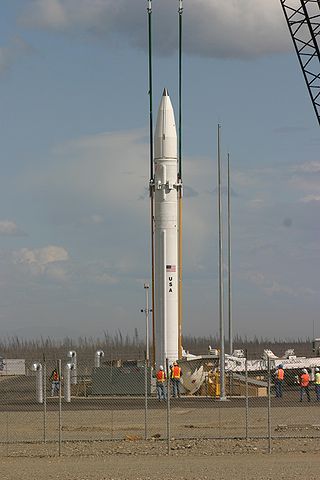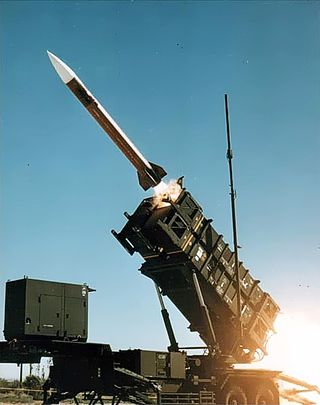
An anti-ballistic missile (ABM) is a surface-to-air missile designed to counter ballistic missiles. Ballistic missiles are used to deliver nuclear, chemical, biological, or conventional warheads in a ballistic flight trajectory. The term "anti-ballistic missile" is a generic term conveying a system designed to intercept and destroy any type of ballistic threat; however, it is commonly used for systems specifically designed to counter intercontinental ballistic missiles (ICBMs).

An intercontinental ballistic missile (ICBM) is a ballistic missile with a range greater than 5,500 kilometres (3,400 mi), primarily designed for nuclear weapons delivery. Conventional, chemical, and biological weapons can also be delivered with varying effectiveness, but have never been deployed on ICBMs. Most modern designs support multiple independently targetable reentry vehicle (MIRVs), allowing a single missile to carry several warheads, each of which can strike a different target. The United States, Russia, China, France, India, the United Kingdom, Israel, and North Korea are the only countries known to have operational ICBMs.

The Ballistic Missile Defense Organization (BMDO) was an agency of the United States Department of Defense that began on 20 May 1974 with the responsibility for all U.S. ballistic missile defense efforts. It was renamed the Missile Defense Agency in 2002.

National missile defense (NMD) refers to the nationwide antimissile program the United States has had in development since the 1990s. After the renaming in 2002, the term now refers to the entire program, not just the ground-based interceptors and associated facilities.

The Exoatmospheric Kill Vehicle (EKV) is the Raytheon-manufactured interceptor component with subcontractor Aerojet of the U.S. Ground-Based Midcourse Defense (GMD), part of the larger National Missile Defense system.

Ground-Based Midcourse Defense (GMD) is the United States' anti-ballistic missile system for intercepting incoming warheads in space, during the midcourse phase of ballistic trajectory flight. It is a major component of the American missile defense strategy to counter ballistic missiles, including intercontinental ballistic missiles (ICBMs) carrying nuclear, chemical, biological or conventional warheads. The system is deployed in military bases in the states of Alaska and California; in 2018 comprising 44 interceptors and spanning 15 time zones with sensors on land, at sea, and in orbit. In 2019, a missile defense review requested that 20 additional ground-based interceptors be based in Alaska.

The Missile Defense Agency (MDA) is a component of the United States government's Department of Defense responsible for developing a comprehensive defense against ballistic missiles. It had its origins in the Strategic Defense Initiative (SDI) which was established in 1983 by Ronald Reagan and which was headed by Lt. General James Alan Abrahamson. Under the Strategic Defense Initiative's Innovative Sciences and Technology Office headed by physicist and engineer Dr. James Ionson, the investment was predominantly made in basic research at national laboratories, universities, and in industry. These programs have continued to be key sources of funding for top research scientists in the fields of high-energy physics, advanced materials, nuclear research, supercomputing/computation, and many other critical science and engineering disciplines—funding which indirectly supports other research work by top scientists, and which was most politically viable to fund within the Military budget of the United States government. It was renamed the Ballistic Missile Defense Organization in 1993, and then renamed the Missile Defense Agency in 2002. The current director is U.S. Navy Vice Admiral Jon A. Hill.

The United States Army Space and Missile Defense Command (USASMDC) is the Army Service Component Command (ASCC) for United States Strategic Command and United States Space Command. It was established in 1985 as the Army Strategic Defense Command, responsible for ballistic missile defense. In 1992, it merged with Army Space Command to become Army Space and Strategic Defense Command. In 1997, it became an Army Major Command and was redesignated Army Space and Missile Defense Command.

Missile defense is a system, weapon, or technology involved in the detection, tracking, interception, and also the destruction of attacking missiles. Conceived as a defense against nuclear-armed intercontinental ballistic missiles (ICBMs), its application has broadened to include shorter-ranged non-nuclear tactical and theater missiles.

The AN/FPS-108 COBRA DANE is a PESA phased array radar installation operated by Raytheon for the United States Space Force at Eareckson Air Station on the island of Shemya, Aleutian Islands, Alaska. The system was built in 1976 and brought online in 1977 for the primary mission of gathering intelligence about Russia's ICBM program in support of verification of the SALT II arms limitation treaty. Its single face 29 m (95 ft) diameter phased array radar antenna 52.7373°N 174.0914°E faces the Kamchatka Peninsula and Russia's Kura Test Range. COBRA DANE operates in the 1215–1400 MHz band.
Anti-ballistic missile defense countermeasures are tactical or strategic actions taken by an attacker to overwhelm, destroy, or evade anti-ballistic missile defenses.

The Alaska Army National Guard is a component of the United States Army and the Alaska Department of Military and Veterans Affairs. Along with the Alaska Air National Guard, it makes up the Alaska National Guard. Alaska Army National Guard units are trained and equipped as part of the United States Army. The same ranks and insignia are used and National Guardsmen are eligible to receive all United States military awards. The Alaska Guard also bestows a number of state awards for local services rendered in or to the state of Alaska.
The Space Tracking and Surveillance System was a pair of satellites developed by the United States Missile Defense Agency (MDA) to research the space-based detection and tracking of ballistic missiles. Data from STSS satellites could allow interceptors to engage incoming missiles earlier in flight than would be possible with other missile detection systems. The STSS program began in 2001, when the "SBIRS Low" program was transferred to MDA from the United States Air Force. In December 2002, SBIRS Low Research & Development was renamed Space Tracking and Surveillance System (STSS).

The 7th Space Warning Squadron (SWS) is the premier Space Domain Awareness sensor on the West Coast. The unit was originally established to guard the U.S. West Coast against sea-launched ballistic missiles from the eastern outskirts of Beale Air Force Base approximately 8 miles (13 km) east of Marysville, California. 7 SWS is a geographically separated unit of Space Delta 4.

The Joint Tactical Ground Station (JTAGS) is the United States Space Force's element to United States Strategic Command's Theater Event System (TES). TES provides an integrated, in-theater, 24-hour overhead non-imaging infrared detection capability for processing and disseminating missile early warning, alerting, and cueing information data to combatant commanders and missile defense assets through the use of stereo processing of the Defense Support Program (DSP) satellite data.
Vandenberg Space Force Base Launch Facility 02 (LF-02) is a former US Air Force Intercontinental ballistic missile launch facility on Vandenberg SFB, California, USA. It was a launch site for the land-based Minuteman and Peacekeeper missile series. In the 2000s the silo was remodeled into a launch site for an Interceptor for the Ground-Based Midcourse Defense System.

The Ground-Based Interceptor (GBI) is the anti-ballistic missile component of the United States' Ground-Based Midcourse Defense (GMD) system.

The Exoatmospheric Reentry-vehicle Interceptor Subsystem, or ERIS, program, was a component of the United States' Strategic Defense Initiative during the Cold War. The ERIS system was named after Eris, Greek goddess of strife. ERIS was a kinetic kill system, launched from a ground-based system, and impacting directly to destroy an incoming Intercontinental ballistic missile (ICBM) before the targeted ICBM re-entered the Earth's atmosphere.

The 1st Space Brigade is a United States Army unit. Assigned to the United States Army Space and Missile Defense Command, it is responsible for providing space combat power support to Army units. Activated in 2005 as a TOE unit after being provisionally active since 2003, it is headquartered at Colorado Springs, Colorado.

The United States Army Integrated Air and Missile Defense [IAMD] Battle Command System (IBCS) is a plug and fight network intended to let any defensive sensor feed its data to any available weapon system. The system is designed to shoot down short, medium, and intermediate range ballistic missiles in their terminal phase by intercepting with a hit-to-kill approach. IBCS has been developed since 2004, with the aim to replace Raytheon's Patriot missile (SAM) engagement control station (ECS), along with seven other forms of ABM defense command systems. In 2022, IBCS successfully completed initial operational test and evaluation (IOT&E), and was approved for full-rate production in 2023.















